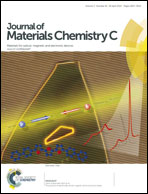The influence of the diphenylphosphoryl moiety on the phosphorescent properties of heteroleptic iridium(iii) complexes and the OLED performance: a theoretical study†
Abstract
A series of heteroleptic iridium(III) complexes were investigated by using the density functional theory/time-dependent density functional theory (DFT/TD-DFT) approach to determine the influence of the diphenylphosphoryl (Ph2PO) moiety on the electronic structures, phosphorescent properties and the organic light-emitting diode (OLED) performance. The results reveal that the introduction of the Ph2PO group could not only dramatically change the electron density distributions of the LUMO and cause red shifts of the emission wavelengths, but also increase the oscillator strengths and the metal character, thus leading to larger radiative decay rates. Additionally, compared with FIrpic (a widely used kind of blue guest material in OLED devices), those complexes with Ph2PO substituents could improve the electron injection/balance ability, increase the Förster energy transfer rate and confine the triplet excitons to the guest phosphors, hence resulting in better OLED performance. Interestingly, further analysis indicates that, compared to IrpicPO with the Ph2PO group sited at the phenyl ring of the phenylpyridine (ppy) ligands, IrpicPOpy with the Ph2PO group sited at the pyridine ring of the ppy ligands performs better in the hole-trapping and hole-injection ability. Finally, we hope our investigations will facilitate the future design of high efficient phosphorescent materials.


 Please wait while we load your content...
Please wait while we load your content...